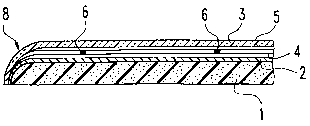Some of the information on this Web page has been provided by external sources. The Government of Canada is not responsible for the accuracy, reliability or currency of the information supplied by external sources. Users wishing to rely upon this information should consult directly with the source of the information. Content provided by external sources is not subject to official languages, privacy and accessibility requirements.
Any discrepancies in the text and image of the Claims and Abstract are due to differing posting times. Text of the Claims and Abstract are posted:
| (12) Patent Application: | (11) CA 2194754 |
|---|---|
| (54) English Title: | SUPPORT FOR COMPUTER MOUSE |
| (54) French Title: | SUPPORT POUR SOURIS D'ORDINATEUR |
| Status: | Deemed Abandoned and Beyond the Period of Reinstatement - Pending Response to Notice of Disregarded Communication |
| (51) International Patent Classification (IPC): |
|
|---|---|
| (72) Inventors : |
|
| (73) Owners : |
|
| (71) Applicants : |
|
| (74) Agent: | CASSAN MACLEAN |
| (74) Associate agent: | |
| (45) Issued: | |
| (86) PCT Filing Date: | 1995-07-11 |
| (87) Open to Public Inspection: | 1996-01-25 |
| Availability of licence: | N/A |
| Dedicated to the Public: | N/A |
| (25) Language of filing: | English |
| Patent Cooperation Treaty (PCT): | Yes |
|---|---|
| (86) PCT Filing Number: | PCT/EP1995/002690 |
| (87) International Publication Number: | WO 1996002041 |
| (85) National Entry: | 1997-01-09 |
| (30) Application Priority Data: | ||||||
|---|---|---|---|---|---|---|
|
A support for computer mouse (mouse pad) has at least one thin coloured liquid
layer arranged on a bottom foam plate and enclosed between two foils arranged
on the bottom plate and welded together in a liquid-tight manner at their
edges. The thin coloured liquid layer may be seen through the transparent
foils. Since the liquid does not completely fill the available space, it is
constantly redistributed, forming ever-changing streaked patterns every time
the mouse is actuated, and giving to the mouse pad an optically interesting
optical appearance.
Un support pour souris d'ordinateur (tapis pour souris) comprend, disposée sur une feuille inférieure en mousse, au moins une mince couche colorée de liquide contenue entre deux feuilles positionnées sur la feuille inférieure et soudées l'une à l'autre par leurs bords de manière étanche aux liquides. La mince couche colorée de liquide est visible à travers les feuilles transparentes. Etant donné que le liquide ne remplit pas entièrement l'espace disponible, il se répartit constamment, formant des motifs à stries qui se modifient à chaque fois que l'on actionne la souris, ce qui donne un aspect optiquement intéressant au tapis pour souris.
Note: Claims are shown in the official language in which they were submitted.
Note: Descriptions are shown in the official language in which they were submitted.

2024-08-01:As part of the Next Generation Patents (NGP) transition, the Canadian Patents Database (CPD) now contains a more detailed Event History, which replicates the Event Log of our new back-office solution.
Please note that "Inactive:" events refers to events no longer in use in our new back-office solution.
For a clearer understanding of the status of the application/patent presented on this page, the site Disclaimer , as well as the definitions for Patent , Event History , Maintenance Fee and Payment History should be consulted.
| Description | Date |
|---|---|
| Inactive: IPC expired | 2013-01-01 |
| Inactive: IPC deactivated | 2011-07-29 |
| Inactive: First IPC derived | 2006-03-12 |
| Inactive: IPC from MCD | 2006-03-12 |
| Time Limit for Reversal Expired | 2003-07-11 |
| Application Not Reinstated by Deadline | 2003-07-11 |
| Inactive: Status info is complete as of Log entry date | 2002-09-27 |
| Inactive: Abandon-RFE+Late fee unpaid-Correspondence sent | 2002-07-11 |
| Deemed Abandoned - Failure to Respond to Maintenance Fee Notice | 2002-07-11 |
| Letter Sent | 2001-03-15 |
| Inactive: Office letter | 1999-11-04 |
| Inactive: Multiple transfers | 1999-10-14 |
| Application Published (Open to Public Inspection) | 1996-01-25 |
| Abandonment Date | Reason | Reinstatement Date |
|---|---|---|
| 2002-07-11 |
The last payment was received on 2001-07-06
Note : If the full payment has not been received on or before the date indicated, a further fee may be required which may be one of the following
Please refer to the CIPO Patent Fees web page to see all current fee amounts.
| Fee Type | Anniversary Year | Due Date | Paid Date |
|---|---|---|---|
| MF (application, 2nd anniv.) - standard | 02 | 1997-07-11 | 1997-07-08 |
| MF (application, 3rd anniv.) - standard | 03 | 1998-07-13 | 1998-06-24 |
| MF (application, 4th anniv.) - standard | 04 | 1999-07-12 | 1999-06-15 |
| Registration of a document | 1999-10-14 | ||
| MF (application, 5th anniv.) - standard | 05 | 2000-07-11 | 2000-07-07 |
| MF (application, 6th anniv.) - standard | 06 | 2001-07-11 | 2001-07-06 |
Note: Records showing the ownership history in alphabetical order.
| Current Owners on Record |
|---|
| HIRSCH & PARTNER GMBH |
| Past Owners on Record |
|---|
| KARL HIRSCH |